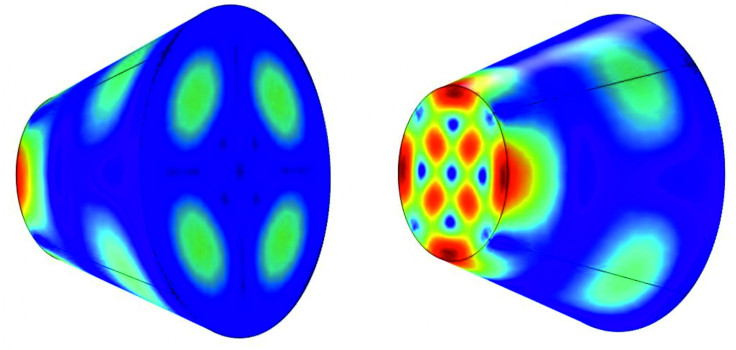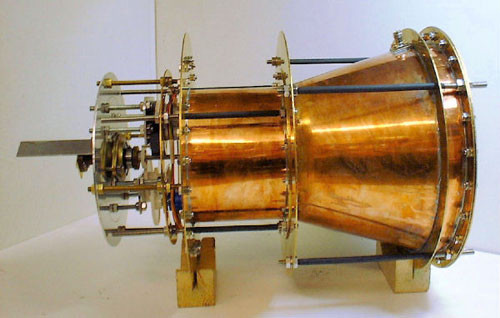EmDrive: Finnish physicist says controversial space propulsion device does have an exhaust
A new study proves that the EmDrive does indeed have an exhaust.

A new peer-reviewed paper on the EmDrive from Finland states that the controversial electromagnetic space propulsion technology does work due to microwaves fed into the device converting into photons that leak out of the closed cavity, producing an exhaust.
The research, entitled "On the exhaust of electromagnetic drive", is published in the journal AIP Advances 6 and is the brainchild of Dr Arto Annila, a physics professor at the University of Helsinki; Dr Erkki Kolehmainen, an organic chemistry professor at the University of Jyväskylä; and Patrick Grahn, a multiphysicist at engineering software firm Comsol.
British scientist Roger Shawyer devised the EmDrive concept and first presented it in 1999, but spent years having his technology ridiculed by the international space science research community. According to Shawyer, if the technology is ever commercially realised, EmDrive could transform the aerospace industry and potentially solve the energy crisis, end climate change and speed up space travel by making it much cheaper to launch satellites and spacecraft into orbit.
Yet despite the controversy attached to the technology, since 2012 nine independent studies have been carried out by scientists from China, Germany and even Nasa to try to build and test their own versions of the EmDrive. Although the researchers are not sure why, they have all discovered signals of thrust that cannot be explained.
If the Finnish researchers are right about their theory explaining how exactly the EmDrive is able to produce thrust, then other scientists would be able to build better cavities that produce more thrust as they would understand how to detect the exhaust being produced.
The basic principle of nature

How the EmDrive works
The EmDrive is the invention of British scientist Roger Shawyer, who proposed in 1999 that based on the theory of special relativity, electricity converted into microwaves and fired within a closed cone-shaped cavity causes the microwave particles to exert more force on the flat surface at the large end of the cone (i.e. there is less combined particle momentum at the narrow end due to a reduction in group particle velocity), thereby generating thrust.
His critics say that according to the law of conservation of momentum, his theory cannot work as in order for a thruster to gain momentum in one direction, a propellant must be expelled in the opposite direction, and the EmDrive is a closed system.
However, Shawyer claims that following fundamental physics involving the theory of special relativity, the EmDrive does in fact preserve the law of conservation of momentum and energy.
Annila has been researching the basic principle of nature for the last decade, which states that any difference in energy (i.e. force) will level off in the least available amount of time.
To that end he has had just under 50 papers published in many well-established journals whereby his theory has been applied to understand astronomical observations without dark energy and dark matter, evolution (origins of life), economics (law of supply and demand is essentially an energetic balance) and consciousness in frontiers of neural science.
And now, he has applied his theory to the EmDrive and found that it proves that the EmDrive does indeed have an exhaust.
"The EmDrive is an engine like any other engine. It takes in fuel and produces exhaust. The fuel side is easy for everyone to grasp – microwaves are being fed in. The trouble is, we don't see anything coming out, which is why people think it doesn't work," Annila told IBTimes UK.
"So how could something come out that you can't detect? Well, the photons bounce back and forth inside the metal cavity, and some of them end up going together in the same direction with the same speed, but they are 180 degrees out of phase. Invariably, when travelling together in this out-of-phase configuration, they cancel each other's electromagnetic field out completely.
"That's the same as water waves travelling together so that the crest of one wave is exactly at the trough of the other and cancelling each other out. The water does not go away, it's still there, in the same way the pairs of photons are still there and carrying momentum even though you can't see them as light.
"If you don't have electromagnetic properties on the waves as they have cancelled each other out, then they don't reflect from the cavity walls anymore. Instead they leak out of the cavity. So we have an exhaust – the photons are leaking out pair-wise."

The EmDrive does work, but there's still a long way to go
Annila says that this idea about photons has been around since Sir Isaac Newton first hypothesised about how light works in the 1600s, and that the EmDrive follows the same basic principle of nature as everything else.

"Everything that happens in nature is a process. Every engine has a process, it needs a fuel and an exhaust. The EmDrive has the same operational principle as everything else," he said. "The general principle of nature is an amazing thought, and sure it is unbelievable thought for every specialist, since it makes every special theory redundant."
Annila says that rather than instantly being discredited because the topic is EmDrive, since many in the global scientific community still don't believe it works, more experimentation needs to be done. He mentions that British physicist Dr Mike McCulloch's theory of quantised inertia is on the right track, and like McCulloch, he also isn't sure that Shawyer fully understands the real reason why the EmDrive works.
"We have a phenomenon. It needs to be debated and taken up, if there is something about it. The scepticism doesn't help. We would not have written the paper if we thought Shawyer was right. I don't think what he said makes perfect sense. I'm not saying it's not making some sense though," Annila stressed.
"I want to see it proven that I'm wrong. A scientist must defend his or her ideas as long as one is absolutely sure that it is wrong. It takes a great skill to measure these sorts of things and people have undoubtedly failed. It is trouble but at the same time I know it can be done and I'm convinced the engineers at Nasa have done proper work.
"The inventors [of the EmDrive] will benefit most when they start to think how the cavity can make the most exhaust. If they understand the way it works, they ought to be able to design it better."
© Copyright IBTimes 2025. All rights reserved.






















